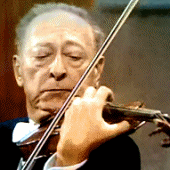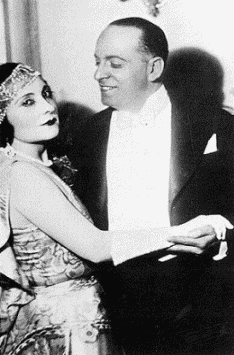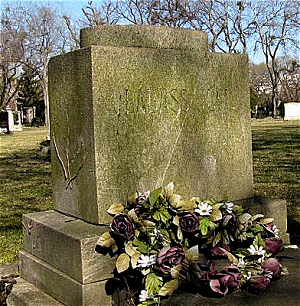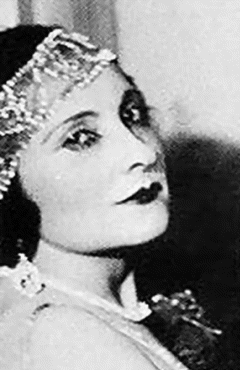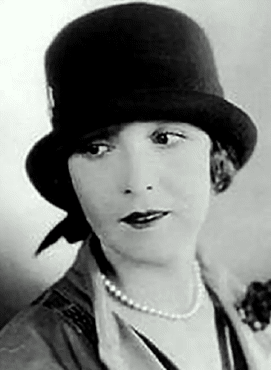![]()
|
HEIFETZ
and his
women, seemingly a life-long love-hate relationship. Officially twice
married, twice divorced. As an old man, in rare moments of introspection,
he would admit that both marriages might have been a mistake. As a
highly successful musician fully dedicated to his art and constantly on
the road, he should have never married or try to raise a family, he
ruefully confessed. It would appear perhaps that he was torn between the two ways of life and
had twice tried to
accomplish both. The first major feminine influence in his life was naturally his mother Anna (Chaya). She was described by various sources as a basic, simple woman, shrewd when necessary and with a good business sense. Back in Vilna she tried her hand at various enterprises in order to complement her husband's violin playing irregular income. Once Jascha started earning good money from concerts, it is said that it was Anna who held and managed the family purse, leaving Rubin to "interfere", as someone put it, with Jascha's violin practice. Those close to the violinist in later years are inclined to attribute, at least in part, his relentless quest for perfection on his never having received definite approval in his childhood for his musical abilities. "It's not good enough", would his mother repeatedly tell him, notwithstanding that she would have had little idea herself what musically "good enough" might be. 'Not good enough', or 'Not too bad' would become Heifetz's own lifetime adjectives for describing someone's achievement, as a substitute for a compliment. The next feminine influence would occur during his teenage years, yet next to nothing is known about that. There were certainly nice young ladies in Leopold Auer's class on whom Heifetz could aim his teenage Cupid arrows. He seemed to recall with some fondness one, Cecilia Hansen, although he'd be careful to note that it was her playing that appealed to him (Hansen was a talented violinist who also happened to be an attractive young girl). Not long after arriving to America, Heifetz started to take full advantage of his stage and personal appeal. But together with his relationship with the opposite gender, a new passion seemed to take hold of him: the movies. While opera was already an established preference, Heifetz appeared to have been smitten by the movie medium and became such an enthusiastic amateur photographer, that he carried the large (camera) box on most of his journeys. We are talking about the silent movie era where scenes were acted accompanied by unrelated music, and occasional subtitles expressing the conversational interaction on screen. More than anything else though, Heifetz appeared to have been infatuated by the glamorous queens of the silent screen. Florence Arto Vidor, former wife of producer King Vidor, was a very popular actress at the time and she seemed to have concentrated Heifetz's attention more than most. Many years later he admitted that when he saw her on screen he made his mind up that she would become his wife, come what may (kumquat may - another one of his tongue twisters). She did so, in 1928, and her seven years old daughter Suzan, from her previous marriage, was adopted by Heifetz. No biographical material on Heifetz that I know of mentions the fact that before Florence Vidor had became the focus of Heifetz's attention, there was another lady who a year or so previously had managed to capture his attention. It may not be a well known fact that in 1926 Heifetz was engaged to another actress, as the Time magazine of the time wrote.
An actress named 'Juca Labass' proved impossible to locate, but one, Juci Labass, was. It seems that the two are one and the same. Labass was a popular variety actress in Budapest, born on 22 July 1896 in Zilah, Hungary (now Zalau, Romania), and died on 24 August 1932, in Budapest. She appeared in various operettas and secondary films such as 'The Grüne Manuelle' (1920, 'Mágia' (1917) and 'A Föld rabjai' (1917), nowadays totally forgotten, indifferent gems of the silent movie era.
It is not known what caused Labass to die at the young age of 36. By then Heifetz was already married for four years to Florence. It is also unclear why the Time magazine named her as Juca instead of Juci. One or the other may be a moniker or a diminutive, but her stage name was Juci Labass.
From a research point of view of Heifetz's life, it has been a rather challenging trail to identify this mysterious woman to whom he allegedly had been engaged. Could it all have been a mistaken identity or was there more substance to it? The usual search through the major search engines brought up no trace of Labass. This seemed odd since she was a singer, variety actress and, for a short while, quite a 'histrionic' prima donna, as one (eventually) located source described her. Reaching a dead end with these searches, it occurred to me that I should turn to localized engines such as the Hungarian language, which I do not speak. At last I got luckier and references to Juci Labass finally started to surface. The more I delved, the more I was struck by the (albeit mild) possibility of mistaken identity. The photos of Juci Labass and that of Florence, who less than two years later became his wife were, to me, quite striking. Their respective birthdates were also unusually similar (July 1896 for Labass and July 1995 for Florence Vidor). Here are close up photos of the two actresses.
Well, although somewhat different, both sport the hairdo and the mandatory accentuated mid upper lip "V" of the time. To me, Labass has the more distant, aloof, somewhat colder look while Florence's is warmer and more vulnerable. If not altogether the same woman, it appears to point at least toward the type of looks that attracted Heifetz in those years. Eventually the existence or otherwise of this early amorous liaison was almost entirely solved by Heifetz himself - indirectly of course, as was his wont. In 1928, just prior to marrying Florence, Heifetz was interviewed by a journalist of the Chicago American for an article entitled "Heifetz Here, Batchelor yet, he says". (the Chicago American incidentally was a rather aggressive investigative paper, which sported many extravagant headlines. When architect Frank Lloyd Wright announced plans to build a mile tall building in Chicago, the American stole the plans and printed them. Serendipitously, it was one of Wright's sons, Lloyd Wright Jr., who later designed and built Heifetz's studio in Beverly Hills). The American journalist asked Heifetz about reports that he is to marry comedy star Juca Labass from Budapest and Heifetz retorted (courtesy of Dario Sarlo): "But that report is two years old! I would rather discuss music rather than musical comedy actresses". Typical Heifetz. He didn't deny the report and in the process he indirectly also confirmed that he is familiar with the name and the profession of the lady in question. It was certainly a tongue-twisting reply and a confirmation - of sorts. Two and four years into the marriage respectively, Jascha's and Florence's two children, Josefa (Joesepha) and Robert were born. Heifetz had been concertizing and touring extensively. The peripatetic life presented him no doubt with countless encounters and opportunities to meet glamorous society ladies at post concert dinners, banquets and elsewhere. By the end of WWII the couple marriage came to an end. One of the society ladies he had met, Frances Spiegelberg, eventually managed to cast a spell on him. Decades later Heifetz admitted that he became infatuated with her. Florence was aware of the presence of a new woman in her husband's life. Although it appears that she was willing to accord him the freedom to continue that alliance, she asked him, for the benefit of the children, not to walk away and break up the family. The divorce from Florence occurred in 1946. It might have come as a result of an 'ultimatum' the new lady had imposed, something along the lines of 'it's me or her', but this is not substantiated. Again, the Time magazine reported dryly:
Notwithstanding Florence's given age, the motive for divorce might have raised an eye brow or two. It appears that Heifetz had to come up with some reasons for divorce and that was one of them. To substantiate it, he had summoned his friend Rudolph (Rudy) Polk to testify on his behalf that "every time we were out in social gatherings, my wife belittled me" as a musician. Not five years later, Polk himself would became the legal target of Heifetz's wrath in a separate, commercial lawsuit. The years following the divorce were somewhat unsettled. Two years almost to the date, the Time magazine informed readers that Heifetz:
This period of his life also coincided with his first major personal loss, the death of his mother Anna. Perhaps by now he sensed that he needed some time out, what with the turmoil of the War years, the breakup of his marriage and the death of his mother. His announced sabbatical away from the concert stage lasted almost two years. During this time, his third child, Joseph (Jay), was born. In 1957 his father Rubin died at old age. Soon after, the cracks in his second marriage had surfaced, which eventually led to the second divorce. These were testing times and Heifetz had to cancel a concert in London, due to nervous exhaustion. Financial arrangements were difficult to settle. According to Time magazine
The papers reported that Frances divorced him, charging that he had tried to lock her out of their Beverly Hills home. There were allegations of over-spending and that Heifetz's Bentley was impounded due to debts incurred by Mrs. Heifetz in his absence. Eventually the commotion calmed down. Heifetz was alone again. Decades later, with hindsight, Heifetz confessed that he might have made a mistake divorcing Florence. He described her as a lady with class and with some admirable qualities. It would be recalled that Florence had the courage and strength to abandon her professional career once the sound movies, the 'talkies', came about. Chinatown Nights (1929) was her last film, which begun as a silent movie but finished with sound by way of voice dubbing. Florence did not dub her own voice and quit the movie business immediately afterward, preferring not to work with sound (her voice in Chinatown Nights was subsequently dubbed by actress Nella Walker). Somewhere deep in his heart Heifetz seemed to still harbor respect and devotion for Florence. He visited her on a number of occasions in Los Angeles. She died in Pacific Palisades, Los Angeles, in 1977, about a year or so after Heifetz's sister Pauline had also passed away. When the news about Florence's death reached him he cried and mourned. During the intervening years leading to his own death, he expressed the wish to be cremated, like Florence, in the same crematorium. He was. Following his second divorce, the feminine influence kept manifesting itself mostly through house keepers. Those came and went at a fast pace. He hired and dismissed them frequently, particularly later in life when his assistant Ayke Agus was in charge of these duties. Interestingly, in spite of his seemingly equivocal attitude toward the fairer gender, Heifetz was similarly surrounded by a number of professional assistants, exclusively females, during his teaching career. Claire Hodgkins, Yukiko Kamei, Sherry Kloss, Ayke Agus, all fulfilled that role and apparently there were no male students who were either gifted enough, or wished, to step into that position. Erick Friedman did mention that he always felt that Heifetz expected him to stay (at USC) and teach, passing on the tradition he had learned from the master. But the East-born Erick Friedman disliked Los Angeles and moved away from it. Other ladies fulfilled the mundane roles of secretaries - although Heifetz managed to inject a measure of 'excitement' and stress even into those duties. Heifetz's relationship with his assistants had its own ups and downs. Some ended in disharmony. The relationship that seemed to last the longest - actually until his death - was the fifteen year long alliance with his last assistant, Ayke Agus. This had been described in details by Ms. Agus in her memoirs Heifetz As I knew Him. From Cecilia Hansen and Juca Labass, through other who shall remain nameless (to some of whom Heifetz had cryptically dedicated transcriptions), two marriages, teaching assistants, secretaries and countless housekeepers and cooks, the women whom he loved to hate, those he wanted to - but apparently couldn't - live without, have surround him until the day he died. |
|||||||





